
When it comes to sparkling stones, diamonds have always been the quintessential symbol of love, luxury, and glamor. However, as more people become conscious of the environmental and ethical impact of diamond mining, the demand for sustainable alternatives has skyrocketed. In response, two new types of diamonds have emerged as popular alternatives to natural diamonds: simulated diamonds and lab-grown diamonds.
While both types offer a more eco-friendly and cost-effective option, they differ significantly in terms of their production process, physical properties, and overall value. In this discussion, we will delve deeper into the similarities and differences between simulated diamonds and lab-grown diamonds and help you decide which one is right for you.
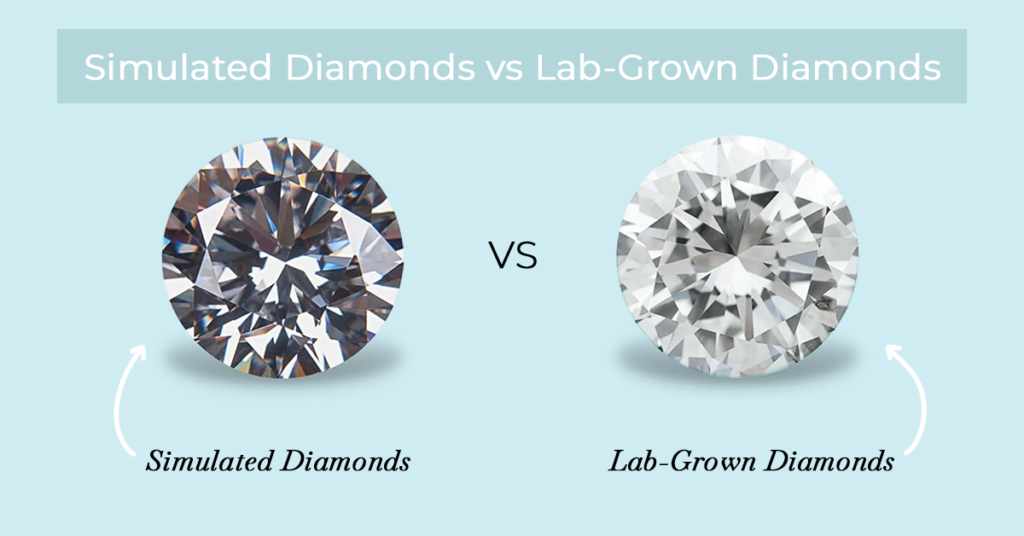
| Criteria | Simulated Diamonds | Lab-Grown Diamonds |
| Source | Man-made | Man-made |
| Composition | Cubic Zirconia or Moissanite | Carbon (identical to natural diamonds) |
| Hardness | Lower than diamond | Identical to natural diamonds |
| Color | Limited range, no natural color | Can have natural colors, or can be colorless |
| Price | Inexpensive | Less expensive than natural diamonds but more expensive than simulated diamonds |
| Value | Low | Higher than simulated diamonds, but less than natural diamonds |
| Environmental impact | Lower than natural diamonds, but still requires energy and resources | Lower than natural diamonds, but still requires energy and resources |
| Durability | Less durable than diamond | As durable as natural diamonds |
| Certification | Not certified | Certified as real diamonds by gemological labs |
| Demand | Less demand | Growing demand as ethical and sustainable alternative to natural diamonds |
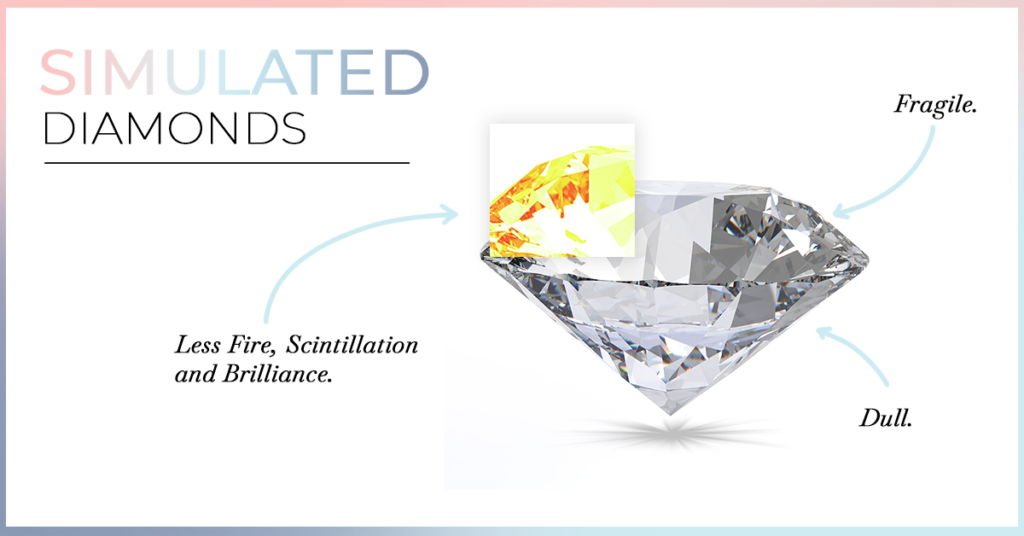
Simulated diamonds are not natural diamonds but are created to look like them. They are used in imitation jewelry mainly because they are colorless and sparkle like diamonds. Due to their lower prices and because they look similar to diamonds, jewelry buyers prefer to buy simulated diamonds.
Simulated diamonds are not made in labs but are simulated materials that look like diamonds. Thus, their physical and chemical composition differs from natural and lab-grown diamonds.
Simulated diamonds are made by processing and polishing naturally occurring colorless and shining gems. One good example is white Zircon which has almost equal brilliance to real diamonds. Certain stimulants like cubic zirconia are made by heating mineral powders, including Zirconium Dioxide, up to 5000 Fahrenheit until it melts and then cools down. As it gains texture, it becomes a shiny, reflective crystal.
This processing makes it look like real diamonds with higher brightness and fire.
Moissanite is available naturally but only in smaller amounts; hence, it’s grown in labs using silicon and carbon by subjecting them to high heat and pressure.
There are many simulated diamonds based on how they are created and processed. Some popular diamond simulants are Moissanite, cubic zirconia, white sapphire, simulant rutile, Swarovski, strontium titanate, cubic zirconia, rhinestones, GGG, YAG, and quartz (rock crystal).
Each one of these is different from the others and is sold at different prices as their processing technologies vary.
As most natural gemstone simulants like Topaz can become dull over time, Moissanite and cubic zirconia are widely used stimulants for their resilience and closer resemblance to real stones.
Though Diamond simulants are a great alternative, consider their pros and cons before buying.
Simulated diamonds are 40 to 50% less expensive than lab-grown diamonds. This is because simulated diamonds fall under the fake diamonds category.
Real diamonds take years to develop and then go through fine work, their price depends on four factors, color, cut, clarity, and carat.
Thus, different variants of diamond simulants cost differently. Moissanite is very close to real diamonds, whereas cubic zirconia of the same size costs 70 to 80% lower than Moissanite’s price. This makes diamond simulants also cheaper than lab-grown diamonds.
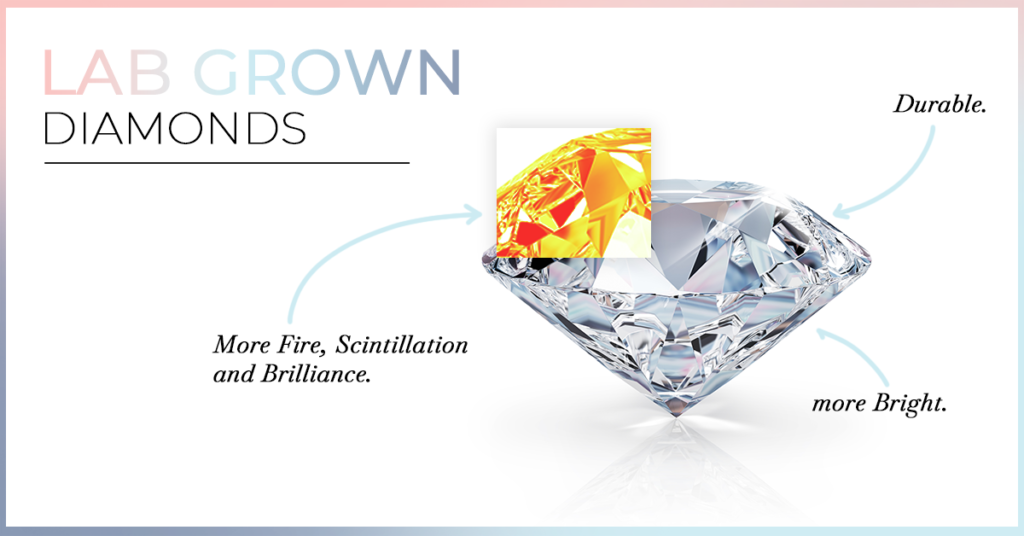
If you want an inexpensive diamond that matches the qualities of real diamonds, then lab-created diamonds are the best option.
The market for lab-grown diamond jewelry is expanding and is predicted to reach a market value of $55.6 billion by 2031. As of 2022, 10% of the diamond sales were solely through lab-created diamonds.
Let’s see the characteristics, price, pros and cons, and types of lab-created diamonds.
Lab-created diamonds are artificially grown diamonds in labs that look like real diamonds. They look exactly similar and have the same chemical and physical properties.
As its name says, these are man-made diamonds grown in labs from a minute diamond seed. There are two ways in which these diamonds are made. Under both methods, it takes several weeks for the diamond to form.
If it’s the high-pressure, high-temperature method, the diamond is coated with atoms and subjected to high pressure and temperature of around 1.5 million pounds/square inch and 2700 Fahrenheit.
The other method Chemical Vapor Deposition lets in chemical vapors that get hardened under pressure and temperature (much lesser than the previous method).
There are two types of lab-created diamonds and this is based on their manufacturing process. They are HPHT and CVD.
HPHT is High-Pressure High-Temperature lab-grown diamonds as they are grown under such conditions. The other type is Chemical Vapour Deposition. Though the way they are created varies, there are no changes in the appearance or price of these diamonds.
The price of lab-grown diamonds is reducing significantly after being sold 2o to 30% higher a few years ago. Right now, they are much cheaper than diamonds and sold at 70% lower prices than real diamonds.
The price of lab-created diamonds is based on the carat, color, shape, clarity, and cut. Therefore, it’s crucial to consider all these factors when comparing prices between natural, lab-grown, and simulated diamonds.Simulated diamonds are less expensive than this, and even the most expensive diamond simulant costs 40 to 50% lower than the real diamond’s cost. It also varies based on the design and provider you choose.
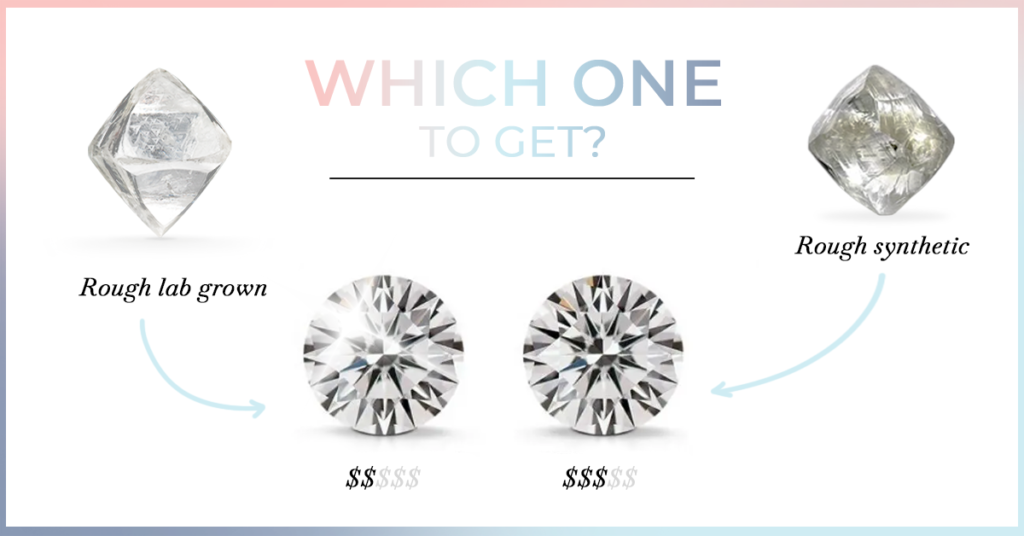
The environmental impact of lab-grown diamonds are generally considered to be lower than that of cubic zirconia and moissanite. The production of cubic zirconia and moissanite involves mining and extraction processes that can have negative impacts on the environment. On the other hand, lab-grown diamonds are created in a controlled laboratory setting using less energy and fewer resources, resulting in a lower carbon footprint. However, it’s worth noting that the exact environmental impact of any product can vary depending on a variety of factors, including the methods used to produce it and the specific practices of the manufacturer.
Lab-created diamond jewelry is the closest option if you are on a budget but want to buy a special gift for your loved ones. They are affordable and are available in a wide range of designs. You can get custom-made designs to suit your liking and budget. There is an increase in couples choosing lab-grown diamonds as wedding or engagement rings. After all, it’s about the affection you have for the other person that wins, and it wouldn’t need any rare gifts to prove itself.
Though simulated diamonds are also lower in price, they can become brittle and dull over the years.
You can go for lab-grown diamonds if you want a shiny, scintillating, and real-like diamond at better prices.
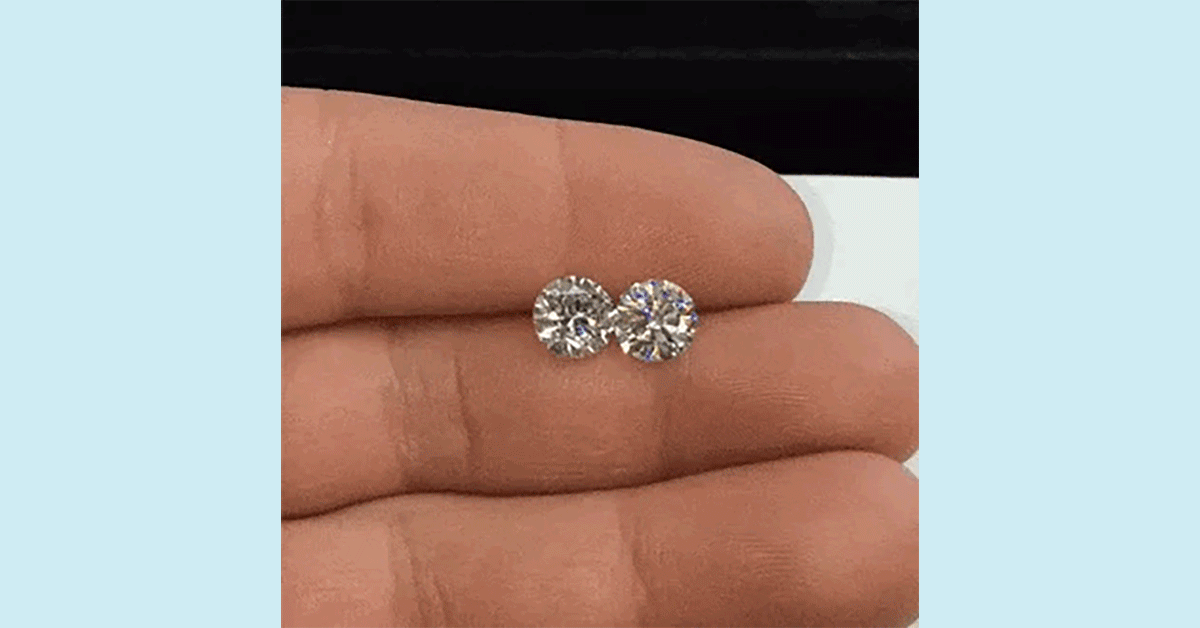
Overall, lab-created diamonds are gaining popularity among modern jewelry buyers, and for good reason. They look just like real diamonds but cost a fraction of the price.
The distinction between a diamond simulant and a lab-grown diamond is easily discernible with the naked eye.
Here, at La Joya, we take extreme care in sourcing ethically grown lab diamonds with superior qualities and present them in the form of beautiful ornaments that you will cherish forever.
Yes. Lab-grown diamonds sparkle exactly like real diamonds as their optical properties are created, keeping real diamonds as a reference.
The biggest flaw of a simulated diamond is that it can become yellow over time. Some simulated diamonds, like Rutile, exhibit more colors than usual, making it easy to spot their fakeness. Diamond simulants can also receive scratches all over the surface and are not suitable for daily wear.
You cannot identify a lab-grown diamond in the engagement ring even if you are experienced in it or use a diamond tester. It needs special diamond-testing equipment as both respond the same way to light.
There is no verdict on which you should buy, as it depends on your budget, preferences, and style. If you want to own diamond jewelry and save for it, buying lab-grown diamonds will save you more money while making your wishes come true.
Shop by metal
Shop by diamond
@ All rights reserved La Joya Jewelry Inc